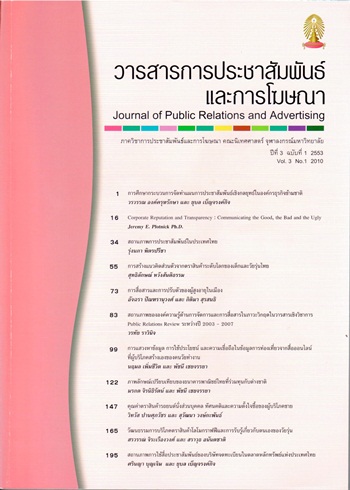สถานภาพการประชาสัมพันธ์ในประเทศไทย
Main Article Content
Abstract
The purpose of this research is to study the professional practice of public relations in Thailand using James E. Grunig’s four models of public relations as the conceptual framework. The results of this research provide a clearer understanding of the status of public relations practice in Thailand based on : 1. The press agent/publicity model, 2. The public-information model, 3. The two-way asymmetrical model, 4. The two-way symmetrical model. For qualitative research, key informants were recruited among 24 PR practitioners and the survey samples for quantitative research were 182 PR practitioners from the private and public sectors including non-profit organizations.
The study has shown that public relations practitioners in each type of organization in Thailand have more or less practiced every stage of the 4 public relations model. In the private sector, the two-way symmetrical model was most practiced, followed by the two-way asymmetrical model and the public-information model respectively. In the government sector and non-profit organizations, the public-information model was most practiced, followed by two-way symmetrical model and the two-way asymmetrical model respectively. The press agent/publicity model was practiced least in every sector. Moreover, the two-way asymmetrical and the two-way symmetrical models were practiced more in the private sector than in the government sector, including state enterprises, demonstrating that the private sector is more concerned about establishing and maintaining a good relationship between an organization and its stakeholders in terms of mutual satisfaction. For this reason, information seeking tools such as public participation and opinion surveys are seen to be the choice of the private sector to establish a positive attitude and mutual satisfaction of stakeholders for their organization’s performance. Meanwhile the practitioners in the government sector, state enterprises and non-profit organizations devote most of their efforts to promoting their organizations to control public attitude and behavior rather than create mutual satisfaction as practiced the private sector.

